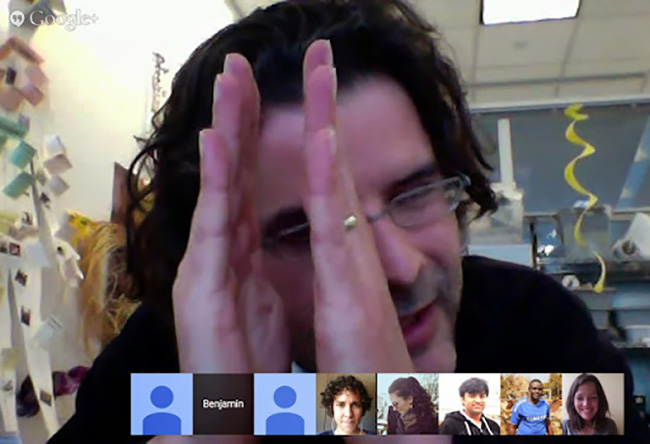
At a time when everything seems to be going online, collaboration tools are turning up! If you are new to collaborating online, MIT’s Office of Experiential learning has a wealth of Tutorials and Best Practices and MIT Media Lab also has also shared a few simple tips for online meetings. But what if you are trying to co-design online? How might we achieve a fun, personal, participatory, and productive feel online?
For a number of years now, MIT D-Lab has been facilitating online collaborations with people from a variety of places - Singapore, India, Kenya, Morocco, Brazil, Colombia, Guatemala, (to name a few) - and a variety of internet connections. The special sauce of our work is how collaborative and engaging it is, so we are always thinking through how to provide more meaningful, interactive sessions online with limited time, internet bandwidth, and resources. Now, as many more people are moving online to collaborate, we thought it would be helpful to share some of our favorite tools and tips. But we know there are even more out there, so I encourage you to share some of your favorite tools and tips here!
Online Collaboration Tools
Zoom - We have found Zoom to be a cost-effective video conferencing platform that has simple, self-explanatory functions and is easy to use in low bandwidth areas. Beyond the whiteboard, chat, polling, and recording functions, we’ve found the digital breakout rooms to be extremely useful when we need to breakout into smaller groups online; the platform even gives the facilitator the option to “go check in” on the different rooms. You can sign up for free online demos here.
Google Slides - Google docs are great for tracking notes, Google sheets are great for looking at budgets and schedules together, but the most useful tool for visual communication has been Google Slides. You can, of course, use Google Slides just to present your own ideas, but it also works fantastically as a whiteboard for everyone on the call to share their ideas: all participants can draw, write and collaborate with no subscription fee. The side perk is that at the end of the call, you already have the group work saved and ready for your next presentation!
Miro - This is a digital workspace designed for online collaboration. It comes stocked with all the design thinking and strategic planning templates your heart could desire! Additionally, it has digital post-its, markers, and spaces for clipping images directly to the “infinite whiteboard.” Best of all, they have three free boards for every account. This is a good platform to work on if you run a lot of design sprints, have stable internet connection, or are a very visual team. They have free (and useful!) webinars weekly on how to use the platform via their fun Miro Academy.
Tips for Online Facilitation
Arrive early to test your tech. As a facilitator of the meeting or class, give yourself grace and time to practice with the technologies before you start, and encourage your participants to arrive 10 minutes early to test the tech as well.
Start with the video on - and give a smile and wave! We recommend keeping your camera on to be fully present - especially at the beginning of the meeting, give each other a smile and wave to enhance the interpersonal connection at the beginning of the call. Then, if you need to turn the video off later on in the call, you can. (And make sure you turn it off: one person once started shaving in front of the video cam without realizing the camera was still on!)
Do a warm-up at the beginning of the call. Research shows that if people hear their own voice at the beginning of a class or session, they are more likely to participate throughout the rest of the session. Be sure to do a warm-up that invites each person to use their voice at the very beginning of the call.
Invite people by name to share. More so than in-person meetings, participants can feel unsure if/how/when to talk during online meetings, especially in the first couple of calls. One way to address this is by setting group norms at the beginning of the call about whether to just jump in and comment, raise your hand, make a comment in the chat and wait to be called on, or something else. Be sure your participants know how and when to participate. We find it helpful to allow seven seconds of silence after asking a question: that’s the average amount of time it takes for a more introverted person to respond. After that, the facilitator can invite someone by name to share their thoughts or questions. If they prefer not to respond, they can always pass the baton back to the facilitator, but that way, it’s clear the silence is not because of audio issues.
Designate someone to monitor the chats and drop-offs. People drop off an online session for a variety of reasons. Designate a technical facilitator to help get people back online and in the room and to catch them up via the chat function if needed. They can also monitor the audio for everyone online so the facilitator doesn’t have to pause as much during the meeting to address technical issues.
Get visual! Looking at the same focal point together is a method of transforming unproductive conflict into productive discourse. It helps people to understand each other better, generate new ideas, and come to a consensus quicker. One big benefit of online meetings is that you can share your screen and all be looking at the same page. Whether explaining through drawing on Google Slides together, mapping and sharing ideas on Miro or writing out notes together on Google Docs - get as visual as possible and watch the ideas flow!
And get physical! Using our hands activates a different part of our brains than what is activated when we just watch and type on a screen. Just because you’re not in the same room doesn’t mean you can’t engage your motor skills. We’ve had several facilitators in our network lead creative exercises that require moving at your desk, dancing beside your desk, or creating objects from home and showing them online. Check out some of our favorite virtual exercises below!

Virtual Team Building Exercises
Picture yourself. For a quick, visual, and vocal warm-up, you can show a slide with a variety of inspiring pictures, then invite each participant to share which picture they feel represents them right now and why. If you have many people on the call, you can move them to breakout rooms and have them share in small groups, then come back as a large group and invite a few people to share with the large group.
Countdown Dance. This is a great warm-up we learned from our friends at DSIL Global for when you’ve been in calls all day long without any movement. Invite all participants to stand for a moment or move a bit away from their computer. Then invite them to shake a different limb counting down 5 to 1 aloud together. Then from 4 to 1, then 3 to 1, etc. until you get to 0 and then jump up. Start slow, then ramp up faster as you go to get to 0.
Digital Working Styles Workout. This is an excellent in-person team formation exercise we had to adapt to facilitate online. In the in-person version of this exercise, the facilitator reads a series of working style preferences and people physically move along the spectrum. To do this online, we adapted the questions in a Google Doc, Online Working Styles Workout, where people can “stand” on the spectrum by marking the line with the first initial of their name or a color marker.
Sketch Modeling + Origami! Sketch modeling is one of our favorite low-cost ways to engage our hands and share ideas at our design workshops. Sketch Modeling can also be a fun warm up on your digital call. To sketch model, just give all your participants a design challenge (ex. for a WASH-themed call, we invited each participant to design a better bathroom) and restrict them to using only the materials available in their room to make their design. They could also try doing this with origami. After five minutes, invite each participant to share their designs with each other.
Three Things! If you want to engage people to build something together as a team, you can move them into breakout rooms with three people each. Invite each person to share one object that they have on hand with their breakout room and then have them combine their three objects into one imaginary object that would improve the quality of their everyday life. After five minutes, you can close the breakout rooms and invite a couple of the groups to share in 30 seconds or less what their new product is, what it does, and how much it would cost.
Try pulling from the other resources out there, like Remote How’s Ultimate Team Building Guide and +Acumen’sTeam Formation Toolkit.
While these are a few of our favorite collaboration tools, tips, and tricks, we would love to hear yours! Please feel free to share some of your favorite tools and tips on the Google sheet here! If necessity is the mother of innovation, I look forward to seeing what digital collaboration tools and exercises are to come next.


